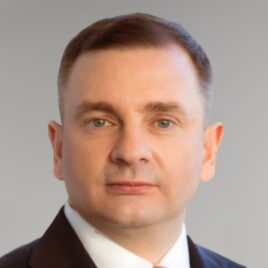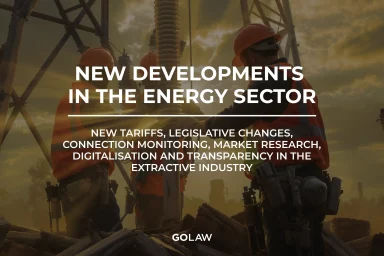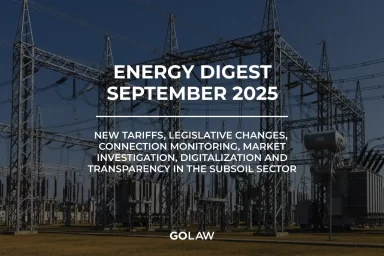Why Ukraine should develop distributed generation?
The Distributed Generation Development Strategy for the period up to 2035, adopted on July 18, 2024, states: “The integrated power system of Ukraine was built as a centralized system with large hub power plants and a power transmission system with high voltage lines.
This structure of the integrated energy system of Ukraine is vulnerable in the context of a full-scale armed aggression of the Russian Federation. Thus, in the event of damage to a large number of generation facilities (power plants) and/or high-voltage transformer substations of the transmission system, a systemic accident with a prolonged power outage for a significant number of consumers may occur.
Given the scale of damage to the existing generating capacities and the need to disperse generation to strengthen the resilience of the power system, there is an urgent need to accelerate the construction and/or deployment of new distributed generation through, inter alia, coordinated organizational, regulatory, legal and economic measures.”
According to the Law on the Electricity Market, distributed generation is a power plant with an installed capacity of 20 MW or less connected to the electricity distribution system.
In more detail, distributed generation is the decentralized production of electricity by small power plants directly near the places of consumption.
Unlike the traditional centralized energy system, where electricity is generated at large power plants and transmitted over long distances through main power lines, distributed generation uses local energy sources.
These can include solar panels, wind power plants, biogas plants, small hydroelectric power plants, gas mini-CHP (combined heat and power plants), and generators based on renewable or traditional energy sources.
Distributed generation is largely based on the use of renewable energy sources, which provides a number of significant advantages, which we will discuss in more detail:
- Reliability and resilience. In the event of accidents or military attacks on energy infrastructure, distributed sources can quickly compensate for losses.
- Reducing losses during electricity transmission. Electricity generation takes place near the place of consumption, which reduces energy losses during its transportation through the main power lines.
- Energy independence. Reducing dependence on fossil fuels.
- Environmental friendliness. The use of renewable energy sources helps to reduce harmful emissions into the atmosphere.
- Sustainable development trend. It helps businesses adapt their operations to the conditions of sustainable development, thereby increasing their competitiveness.
- Flexibility and scalability. Can be adapted for small households, businesses, or large facilities. Flexibility in choosing types of energy sources and the ability to combine different sources makes distributed generation resistant to external factors.
- Rebuilding the energy system to be more inclusive. It will also be directly owned by the population, not just corporations.
- Reducing the cost of electricity. Local energy production reduces the cost of transportation and infrastructure, which leads to a reduction in the overall cost of electricity. Also, as you know, fossil fuels are prone to growth.
- Reducing the load on central grids. Distributed generation avoids overloads and increases the stability of the national power grid.
- Backup and emergency power supply. Backup power for facilities requiring uninterrupted power supply (hospitals, communication systems, water utilities, etc.).
- Stimulating the development of local economies. Installation and maintenance of local energy sources creates new jobs at the local level.
Given the factors listed above, the world is paying more and more attention to the development of distributed generation. The global distributed generation market is showing significant growth. In 2023, its value was estimated at between USD 150 and 250 billion, which is approximately 10-20% of total electricity generation.
In EU countries, distributed generation accounts for an average of about 10% of total electricity production, with Denmark having the highest figure of 50%. According to a survey by the Word Energy Council, more than 50% of energy experts from around the world expect the share of distributed generation to increase by at least 15% of the total installed capacity in their countries by 2025.
Bloomberg New Energy Outlook notes that by 2050, one third of solar power plants will be owned by consumers. This indicates an increased interest in decentralized energy sources and systems that have great potential for energy independence.
As for Europe’s experience in implementing distributed generation, it is quite interesting and useful for Ukraine. However, it should be remembered that there is no similar experience in building a new generation during the war, and this should be taken into account.
Germany, Denmark, and the Netherlands have become leaders in the development of distributed generation using renewable energy sources. Germany has made a significant step in the development of renewable energy sources through its Energiewende program, which provides for a large-scale transformation of the energy system.
The program aims to promote distributed generation at the local level through incentives, grants, and convenient grid connection mechanisms.
Back in the 1990s, a state program to support small solar power plants called Thousand Solar Roofs was created, which later transformed into the Hundred Thousand Solar Roofs program.
This program proved that the roofs of ordinary private houses are well suited for decentralized photovoltaic power generation. An interesting example is the village of Feldheim in Germany, which is fully self-sufficient in energy from renewable resources.
As for Denmark, wind energy is actively developing here. More than 50% of electricity consumption in the country is provided by wind turbines. Local communities are actively investing in local distributed energy projects.
Denmark has also developed a system where heat supply is successfully integrated with electricity balancing. Half of Denmark’s electricity is generated by small combined heat and power plants.
The Netherlands has historically been known for its windmills, and today the country is one of the leaders in the development of modern wind turbines. Another key aspect of the Dutch experience is the active participation of local communities in the development of distributed generation.
By the way, Ukraine also has its own successful cases. Severynivka, in the Zhmerynka district of Vinnytsia region, became an energy-independent village in 2015.
Thus, the European experience in the development of distributed generation is successful due to a combination of innovative technologies, regulatory support and local community participation. At the same time, the main challenges that should be taken into account are identified:
- the instability of renewable sources: solar and wind power are weather-dependent, so there is a need to invest in energy storage and backup capacity;
- integration of new facilities into existing power grids and ensuring their stable operation;
- high initial costs: the development of distributed generation requires significant investments, and this is an issue that is particularly acute for Ukraine.
When implementing a new energy system, it is necessary to pay sufficient attention to modern technological developments, as they play a key role. In particular, we are talking about “smart grids” that act as complementary partners with distributed generation.
Distributed generation creates a need for more sophisticated grid management and balancing, which is provided by smart grids.
These are power grids that use digital technologies to monitor and manage energy production, distribution, and consumption. Modern technological developments also include: energy storage systems (the latest battery technologies allow storing excess energy, ensuring supply stability even under variable generation conditions), the Internet of Things (IoT) (connected devices and sensors allow monitoring and controlling energy consumption at different levels, increasing efficiency and reducing costs) and blockchain technologies (ensure transparency and security of transactions in the energy sector, promote the development of decentralized energy markets and, of course, distributed generation and modern technologies must work in close tandem to achieve good results.
Returning to Ukrainian realities, we can safely say that from an economic point of view, distributed generation is a viable idea for Ukraine. During 2023, solar panels almost halved in price, resulting in 473 GW of new renewable energy capacity being commissioned worldwide (346 GW of which are solar power plants).
For Ukraine, creating a network of 100 solar power plants with batteries may be cheaper than rebuilding destroyed thermal power plants and hydroelectric power plants (which will again become targets for missile strikes).
Of course, local energy sources are also targeted by the enemy, but their capacity is many times smaller, and therefore losses are lower, so damage to one source does not lead to a power outage for all. Also, their damage requires minimal time to repair.
As for legislative innovations, on September 18, 2024, Law No. 3915-IX came into force, which regulates the use of terminology in the field of smart grid implementation (the adopted legal act is a continuation of the Concept for the Implementation of Smart Grids in Ukraine until 2035).
On August 13, the Ukrainian government adopted three important decisions for the development of distributed generation: Resolution of the Cabinet of Ministers of Ukraine No. 761-p “National Renewable Energy Action Plan for the period up to 2030”, Resolution of the Cabinet of Ministers No. 757-p “Some issues of pilot auctions for the distribution of support quotas in 2024” and Resolution of the Cabinet of Ministers No. 756-p “Terms of the tender for the construction of generating capacity and implementation of demand management measures”.
In addition, the connection procedure has been simplified and the Affordable Loans 5-7-9% program has been expanded to speed up the development of distributed generation. A good initiative is the UNDP project “Removing Barriers to Promoting Energy Efficiency Investments in Public Buildings in Small and Medium-Sized Cities of Ukraine through the Energy Service Company Mechanism.”
To implement this project, the Entrepreneurship Development Fund and Globus Bank signed a cooperation agreement. The goal is to provide affordable financing for energy service companies. The work will combine various financial support instruments: interest compensation under the state program “Affordable Loans 5-7-9%”, loan guarantees from the Entrepreneurship Development Fund, and partial repayment of loans to energy service companies with the support of UNDP. The maximum loan amount for one energy service contract is UAH 8 million.
So, now let’s summarize and identify the main steps necessary for the development of distributed electricity generation in Ukraine:
1. Reforming the legal framework:
- improving the legal framework (extending the terms of the law on support for projects with significant investments to distributed objects, creating the position of the first deputy prime minister to coordinate this development);
- introduce a support system for micro and small generators (legislative mechanisms to stimulate small electricity producers, feed-in tariffs, etc.);
- investor protection (protection against regulatory risks, especially in relation to green tariff and compensation for surplus energy produced).
2. Modernization and development of energy infrastructure;
- modernization of power grids (replacement of outdated infrastructure);
- development of “smart grids” (the introduction of “smart grids” will help automate the control and management of electricity production and consumption);
- integration of energy storage systems (development of electricity storage technologies: batteries, hydroelectric power plants).
3. Financial incentives and support:
- state subsidies and tax privileges (introduction of state subsidy programs, especially for small and medium-sized enterprises and private households);
- loan programs and grants (creation of affordable loan programs and grants);
- simplifying the investment model (creating conditions for attracting investments in distributed generation through various financing mechanisms, including crowdfunding models and energy cooperatives);
- creating favorable conditions for attracting international support (attracting grants and loans from international financial organizations such as the World Bank or the European Bank for Reconstruction and Development, etc.).
4. Development of local initiatives:
- support for local initiatives (the ability of communities to develop renewable energy projects on their own, for example, through access to financial instruments or preferential support programs).
5. Information and educational work:
- raising public awareness (conducting information campaigns);
- education and training of specialists (development of professional training programs for relevant specialists).
As you can see, today’s Ukrainian realities give us new phenomena that have potential power and create conditions for building an innovative model of the energy system that will be guided by global trends.
The prospects for distributed generation in Ukraine are promising, so by combining all resources and efforts, we will definitely be able to successfully implement this sector and achieve energy independence and sustainable development.
If you need legal advice, please fill out the form below to request it.

Dr. Valentyn Gvozdiy
Managing Partner, Attorney at law, PhD
- Contacts
- 31/33 Kniaziv Ostrozkykh St, Zorianyi Business Center, Kyiv, Ukraine, 01010
- v.gvozdiy@golaw.ua
- +38 044 581 1220
- Recognitions
- Lexology Index: Corporate Tax 2025
- ITR World Tax 2025
- Lexology Index: Client Choice 2025
- The Legal 500 EMEA 2025
- 50 Leading Law Firms Ukraine 2026
Get in touch
To get a consultation, please fill out the form below or call us right away:Sign up to be aware
New achievements are inspired by information. GO further, don’t miss out GOLAW news and legal alerts
Our expertise
- Energy and Natural Resources
- Antitrust and Competition
- Banking and Finance
- Compliance, Corporate Governance and Risk Management
- Corporate and M&A
- Criminal and White Collar Defence
- Defense in Anti-corruption procedures and regulations
- Labor and Employment
- Natural Resources and Environment
- Government Relations (GR)
- Insolvency and Corporate Recovery
- Intellectual property
- International trade
- Legal support of business and private Сlients in Germany
- Litigation and dispute resolution
- Private clients
- Real Estate and Construction
- Restructuring, Claims and Recoveries
- Martial Law
- Tax and Customs
- Agribusiness
- Aviation
- Chemical industry
- Engineering, Construction and Building Materials
- Environment and Natural Resources
- Financial institutions
- IT and AI
- Industry and manufacturing
- Healthcare industries, Life sciences and Pharmaceuticals
- Media, Entertainment, Sports and Gambling
- Retail, FMCG and E-Commerce
- Transport and Logistics
We use cookies to improve performance of our website and your user experience.
Cookies policy
Cookies settings







